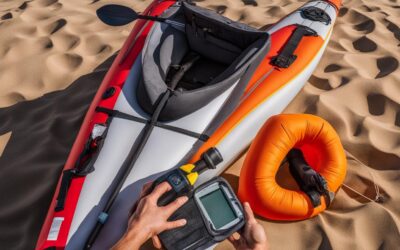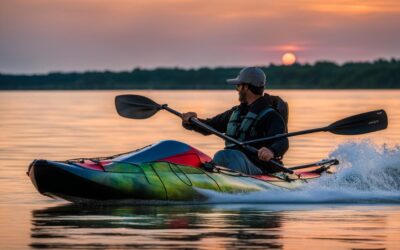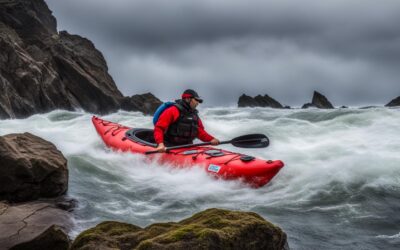Welcome to our comprehensive guide on how to get in and out of a kayak. Whether you’re a beginner or an experienced kayaker, mastering the proper techniques for kayak entry and exit is crucial for a safe and enjoyable paddling experience.
In this article, we will provide you with step-by-step instructions and valuable tips on kayak entry and exit methods, safety considerations, and easy ways to make the process more comfortable. So, let’s dive in and discover the secrets to effortless kayak entry and exit.
Tips for Getting In and Out of a Kayak on a Beach or Ramp
Proper positioning is key when getting in and out of a kayak on a beach or ramp. To make your entry and exit as smooth as possible, start by placing your kayak perpendicular to the shoreline. Position the front half of the kayak in the water and the back half on the sand. This setup allows for an easy launch into the water.
Beach Launch Techniques:
- Position your kayak perpendicular to the shoreline.
- Straddle the kayak and sit down on the back of the cockpit.
- Slide your feet into the cockpit and slide forward into the seat.
- Paddle the kayak onto the sand or into shallow water when getting out.
- Step out one foot at a time, straddle the kayak, or keep both feet on one side.
- Reach forward, grab the front of the cockpit, and pull yourself forward to stand up.
Mastering the art of getting in and out of a kayak on a beach or ramp is crucial for a successful kayaking experience. With these tips and techniques, you’ll be able to confidently enter and exit your kayak, making the most of your time on the water.
Tips for Getting In and Out of a Kayak at a Dock
Entering and exiting a kayak at a dock requires specific techniques to ensure a smooth transition. Whether you’re launching from a floating dock or a fixed one, following these tips will help make the process easier and safer.
1. Position your kayak parallel to the dock
Before getting in or out of your kayak, position it parallel to the dock, preferably where it is lowest and closest to the water. This provides stability and makes it easier to maintain balance during the entry or exit.
2. Sit down next to your kayak
To get into your kayak, sit down next to it on the dock with your feet in the cockpit. Turning your body toward the boat’s bow, carefully lower yourself into the kayak, keeping your weight low. This technique helps maintain stability and minimizes the risk of losing balance.
3. Use the dock for support
When getting out of your kayak at a dock, pull up alongside it and use the dock for support. Hold onto the dock for balance as you step out of the kayak and onto the dock. This allows for a controlled and stable exit.
4. Practice proper dock etiquette
When using a dock for kayak entry and exit, it’s essential to be mindful of other boaters. Avoid blocking access to the dock by quickly and efficiently getting in or out of your kayak. If others are waiting to use the dock, be considerate and move your kayak to a designated area once you’re safely in or out.
5. Consider having a friend assist you
If possible, ask a friend to hold your kayak steady while you enter or exit at the dock. Having someone provide stability can make the process smoother and reduce the risk of accidentally tipping over or losing balance.
By following these tips and practicing entering and exiting your kayak at a dock, you’ll soon develop confidence and skill in kayaking.
Tips for Getting In and Out of a Kayak on a Rocky or Uneven Shoreline
Entering and exiting a kayak on a rocky shoreline or uneven terrain can be tricky, but you can do it safely and confidently with the right techniques. Here are some tips to help you navigate these challenging launch and landing situations:
Kayak Entry and Exit Techniques:
- Choose a stable spot: Look for a flat and stable area along the shoreline where you can safely enter and exit your kayak. Avoid areas with large rocks or loose gravel that could cause you to lose your balance.
- Use your paddle for stability: Place your paddle across the back of your cockpit, perpendicular to your boat. This will provide stability and support as you get in and out of your kayak.
- Take it slow: When getting in, sit on the shore in front of the paddle, put your feet in the boat, and hold the paddle with your hands behind you. Press into the paddle, shift your weight into the seat, and keep your weight low. When getting out, use the same technique in reverse.
Paddle Stabilization:
While on a rocky or uneven shoreline, it’s important to keep your kayak stable using your paddle:
- Position your kayak parallel to the shoreline.
- Hold your paddle horizontally, with one end resting on the shoreline and the other end supported by the cockpit rim.
- As you get in or out of your kayak, use the paddle for balance and stability, ensuring it remains secure in the water and against the shoreline.
Following these tips and techniques, you can confidently enter and exit your kayak on rocky or uneven shorelines, ensuring a safe and enjoyable kayaking experience.
Proper Posture while Sitting in Your Kayak
To fully enjoy your kayaking experience and avoid discomfort or injury, it is crucial to maintain proper posture while sitting in your kayak. Here are some essential kayaking posture tips to help you maintain good form:
- Sit up straight: Position the backrest or seat back of your kayak upright to support a straight spine. Avoid slouching or leaning back, as this can strain your back and shoulders.
- Engage your core: Keep your abdominal muscles engaged to provide stability and support for your lower back. This helps to distribute the workload evenly throughout your body.
- Lift your chest: Lift your chest while maintaining relaxed shoulders. This helps open up your airways for better breathing and improves overall alignment.
- Align your head: Balance your head on your spine, avoiding excessive forward or backward tilting. This promotes better balance and reduces strain on your neck and upper back.
- Position your feet: Place the balls of your feet firmly against the foot pedals or footrests. This allows you to engage your leg muscles for stability and control.
- Externally rotate your legs: Keep your legs externally rotated with your knees pointing outward. This position reduces strain on your lower back and provides a more comfortable sitting posture.
Remember, maintaining proper posture improves your paddling technique, enhances your overall comfort, and prevents unnecessary strain on your body. Practice these kayaking posture tips to optimize your performance and enjoy your time on the water.
Partner-Assisted Kayak Entry and Exit Methods
While getting in and out of a kayak can be challenging, having a paddling partner can make the process much easier and safer. Partner-assisted methods provide additional support, particularly for individuals with mobility limitations or strength issues. Here are two effective techniques for getting in and out of a kayak with a partner:
1. Bracing and Pulling Method
To begin, stabilize your kayak in the water with your legs braced firmly against its sides. Your partner should stand behind you and grip both of your hands. As your partner pulls you up, use your leg strength to push up and get into a seated position in the kayak. This method is helpful for individuals who may have difficulty lifting themselves into the kayak unassisted.
2. Dock and Seat Slide Method
In this method, your partner sits in their kayak while you position yourself on the dock with your feet in the cockpit of your kayak. Your partner can stabilize by holding your kayak while you slide into the seat. This technique benefits individuals who struggle with balance or have limited flexibility.
These partner-assisted methods make entering and exiting a kayak easier and enhance safety by reducing the risk of capsizing or falling. Remember to communicate clearly with your partner and practice these techniques in a controlled environment before attempting them in more challenging conditions.
Tips and Techniques from Experienced Kayakers with Knee Problems
Kayaking with knee problems can still be enjoyable by adopting specific techniques developed by experienced kayakers. One effective method is using shallow water for entry and exit, reducing knee strain.
Additionally, paddle bridge or brace techniques can help stabilize yourself using upper body strength, lessening pressure on the knees. For those with limited flexibility, the straddle or “butt first” approach minimizes knee bending and joint strain.
Alternatively, kayaking with a partner offers extra support, making entering and exiting the kayak easier and safer.
These methods, including shallow water entry, paddle bracing, the straddle approach, and partner assistance, are designed to accommodate kayakers with knee issues.
By integrating these techniques, you can continue to enjoy kayaking without exacerbating knee pain, ensuring a comfortable and safe experience on the water.







